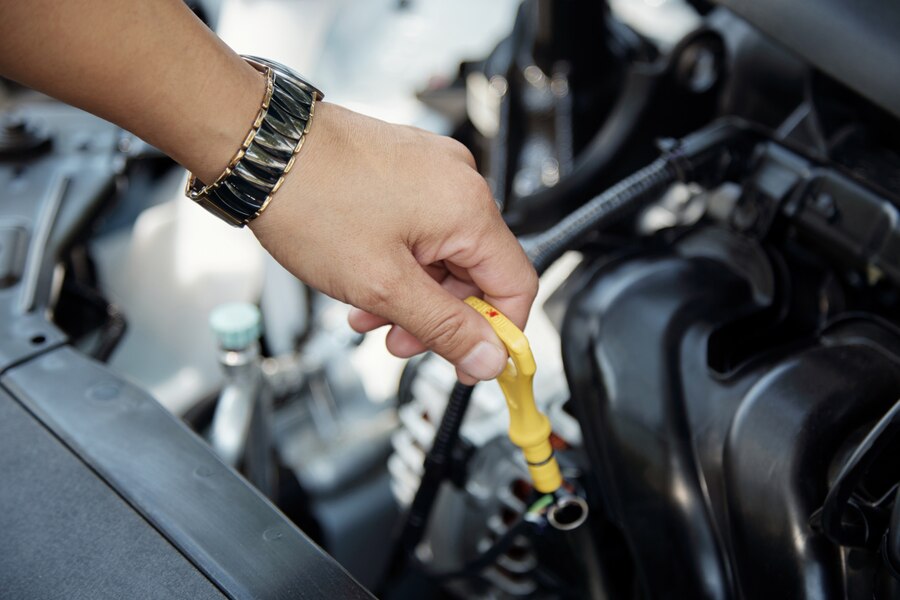Introduction to Motorcycle Oil Changes
Ensuring the longevity and performance of your motorcycle’s engine begins with understanding the crucial maintenance task of oil changes. The question of “how often oil change for motorcycle” is central to this upkeep, dictating the frequency at which you should refresh the vital lubricant that keeps your engine running smoothly. By delving into this topic, riders gain insights into the factors influencing oil change intervals, such as riding habits, environmental conditions, and the type of oil used. With the right knowledge, riders can establish a proactive maintenance schedule, safeguarding their motorcycle’s engine against premature wear and ensuring many miles of enjoyable riding ahead.
Factors Affecting Oil Change Frequency
Several factors influence how often you should change the oil in your motorcycle. The type of motorcycle you own plays a significant role in determining oil change frequency. For example, high-performance sport bikes may require more frequent oil changes compared to cruisers or touring bikes. Additionally, your riding conditions, such as frequent stop-and-go city riding versus long highway trips, can impact oil degradation. The type and quality of oil you use also affect how often you need to change it. High-quality synthetic oils typically last longer and provide better engine protection compared to conventional oils.
General Guidelines for Oil Change Frequency
While manufacturers provide general guidelines for oil change intervals in the owner’s manual, it’s essential to consider additional factors specific to your riding habits and environment. Most manufacturers recommend changing the oil every 3,000 to 5,000 miles or every six months, whichever comes first. However, if you ride aggressively or in extreme conditions, you may need to change your oil more frequently. Regular visual inspections of your motorcycle’s oil can also help determine when it’s time for a change. If the oil appears dark and gritty or smells burnt, it’s best to replace it promptly.
Signs Your Motorcycle Needs an Oil Change
Being able to recognize the signs that your motorcycle needs an oil change is crucial for preventing engine damage. One of the most common indicators is unusual engine noises, such as knocking or ticking sounds, which can signal insufficient lubrication. You may also notice a decrease in engine performance, including sluggish acceleration or difficulty shifting gears. Visually inspecting the oil level and condition can provide valuable insights into your motorcycle’s health. If the oil is low, dirty, or contaminated with metal particles, it’s time for a change.

Step-by-Step Guide for DIY Oil Change
Changing your motorcycle’s oil yourself can save you time and money while giving you a deeper understanding of your bike’s mechanics. Here’s a step-by-step guide to help you perform a DIY oil change:
Gather Necessary Tools and Materials: Before you begin, gather all the tools and materials you’ll need for the job, including oil, an oil filter, a wrench, a drain pan, and a funnel.
Prepare the Motorcycle: Start by warming up the engine to help the oil flow more easily. Then, secure the bike on a center stand or lift for stability.
Drain the Old Oil: Place the drain pan under the oil drain plug and use a wrench to remove the plug. Ensure that the old oil has fully drained before reattaching the drain plug.
Replace the Oil Filter: Use an oil filter wrench to remove the old filter, taking care not to spill any oil. Before fitting the new filter, be sure to coat the gasket with a thin layer of oil for a secure seal.
Refill with Fresh Oil: Use a funnel to pour the recommended amount of fresh oil into the oil filler hole. Check the oil level using the dipstick, and top up if necessary. Once you’ve finished refilling the oil, start the engine and let it run for a few minutes to circulate the new oil throughout the system.

Importance of Using Quality Oil and Filters
Investing in high-quality oil and filters is essential for maintaining your motorcycle’s engine health. Cheap or inferior products may not provide adequate lubrication and protection, leading to premature engine wear and potential mechanical failures. It’s best to stick to reputable brands and follow manufacturer recommendations for oil viscosity and filter type.
Benefits of Regular Oil Changes
Regular oil changes offer numerous benefits for your motorcycle’s engine and overall performance. By removing dirt, debris, and contaminants from the engine, fresh oil helps lubricate moving parts and reduce friction and heat buildup. This, in turn, can improve engine performance, enhance fuel efficiency, and extend the life of critical components. Additionally, routine oil changes can help prevent costly repairs and prolong the lifespan of your motorcycle.
Common Mistakes to Avoid
When it comes to changing your motorcycle’s oil, there are some common pitfalls to watch out for:
Overlooking Oil Levels: Always check your oil levels before and after a ride to ensure they’re within the recommended range.
Using Incorrect Oil Viscosity: Using the wrong oil viscosity can lead to poor engine performance and increased wear.
Neglecting Filter Changes: Don’t forget to replace the oil filter with every oil change to maintain optimal filtration efficiency.

Professional vs. DIY Oil Changes
Deciding whether to perform your motorcycle’s oil changes yourself or leave them to a professional mechanic depends on various factors, including your mechanical aptitude, time availability, and budget. DIY oil changes can be cost-effective and rewarding for those with the necessary skills and tools. However, if you’re uncomfortable performing maintenance tasks or lack the required equipment, it’s best to entrust your bike to a qualified technician. Professional oil changes ensure the job is done correctly and may include additional services like inspection and adjustment of other vital components.
How often should you change oil in a motorcycle?
The frequency of oil changes in a motorcycle depends on various factors, including the type of bike, riding conditions, and oil quality. As a general guideline, manufacturers typically recommend changing the oil every 3,000 to 5,000 miles or every six months, whichever comes first. However, this recommendation can vary based on factors such as aggressive riding, frequent stop-and-go traffic, or extreme weather conditions.
It’s essential to consult your motorcycle’s owner’s manual for specific recommendations tailored to your bike’s make and model. Additionally, factors like high-performance engines, frequent off-road riding, or harsh weather conditions may warrant more frequent oil changes.
Regular visual inspections of the oil level and condition can also help determine when it’s time for a change. If the oil appears dark and gritty or smells burnt, it’s a sign that it’s no longer providing adequate lubrication and should be replaced promptly.
Ultimately, maintaining a consistent oil change schedule is crucial for ensuring optimal engine performance, longevity, and reliability. By staying proactive with your motorcycle’s maintenance and following manufacturer recommendations, you can enjoy many miles of trouble-free riding.

How long can oil sit in a motorcycle before it goes bad?
The duration that oil can sit in a motorcycle before going bad depends on several factors, including the type of oil used, storage conditions, and the motorcycle’s operating environment. In general, most oils have a shelf life of approximately 2 to 5 years when stored properly in a sealed container away from direct sunlight and extreme temperatures.
However, once oil is introduced into a motorcycle engine, its lifespan can be significantly shorter due to factors such as heat, oxidation, and contamination. While modern synthetic oils tend to have a longer service life than conventional oils, it’s essential to adhere to the manufacturer’s recommendations for oil change intervals to ensure optimal engine performance and longevity.
If oil sits unused in a motorcycle for an extended period, it may begin to degrade, leading to a loss of viscosity, lubricating properties, and protective additives. Additionally, moisture buildup and exposure to oxygen can contribute to oil degradation over time.
For motorcycles that are stored for extended periods, such as during the winter months or while undergoing restoration, it’s advisable to change the oil before storing the bike and again upon returning it to regular use. This helps ensure that the engine is adequately lubricated and protected from potential damage due to degraded oil.
Ultimately, while oil can technically sit in a motorcycle for several years without immediately causing harm, it’s essential to monitor its condition and adhere to regular maintenance intervals to prevent potential engine damage and ensure optimal performance when the motorcycle is back on the road.
How long does motorcycle engine oil last?
The lifespan of motorcycle engine oil varies depending on several factors, including the type of oil used, the engine’s design, and the riding conditions. Generally, motorcycle manufacturers recommend changing the oil every 3,000 to 5,000 miles or at least once every six months, whichever comes first.
However, advancements in oil technology, such as synthetic oils, have extended the interval between oil changes for some motorcycles. High-quality synthetic oils can last longer and maintain their viscosity and lubricating properties under higher temperatures and stress conditions. Consequently, some riders may opt for longer intervals between oil changes, typically around 5,000 to 7,500 miles.
It’s crucial to follow the manufacturer’s recommendations outlined in the owner’s manual to ensure optimal engine performance and longevity. Additionally, factors such as frequent short trips, aggressive riding, extreme temperatures, and dusty or dirty environments can accelerate oil degradation and necessitate more frequent changes.
Regularly inspecting the oil level and condition can also provide valuable insights into the engine’s health. If the oil appears dark, gritty, or contaminated with debris, it’s a sign that it’s time for a change, regardless of mileage.
Ultimately, maintaining a consistent oil change schedule and using high-quality oil suited to your motorcycle’s engine requirements are essential for preserving engine performance, reducing wear and tear, and extending the lifespan of your motorcycle.
Conclusion
In conclusion, understanding how often to change your motorcycle oil is essential for maintaining optimal engine health and performance. By following manufacturer recommendations, staying vigilant for signs of oil degradation, and performing regular maintenance, you can enjoy many miles of trouble-free riding. Whether you choose to perform DIY oil changes or leave them to a professional, prioritizing oil change intervals is key to preserving your motorcycle’s longevity and reliability.
FAQs
Can I change motorcycle oil every 2 years?
While it’s technically possible to change motorcycle oil every 2 years, it’s not recommended. Over time, oil can degrade due to exposure to heat, moisture, and contaminants. Even if a motorcycle is not ridden frequently, the oil can still break down and lose its lubricating properties. To ensure optimal engine performance and longevity, it’s best to adhere to the manufacturer’s recommendations for oil change intervals, typically every 3,000 to 5,000 miles or once every six months, whichever comes first.
Do I need to change motorcycle oil every year?
Whether or not you need to change your motorcycle oil every year depends on various factors, including how often you ride, the type of oil used, and environmental conditions. While some riders may be able to go longer between oil changes, others may need to change their oil more frequently, especially if they ride frequently or in harsh conditions. It’s essential to consult your motorcycle’s owner’s manual for specific recommendations and to regularly inspect the oil’s condition to determine if it needs changing.
How do I know if my motorcycle oil is bad?
There are several signs that indicate your motorcycle oil may be bad and in need of changing:
- Dark or gritty appearance: Fresh oil is typically a translucent amber color. If the oil appears dark or dirty, it may be contaminated with debris or engine wear particles.
- Burnt smell: A burnt or foul odor emanating from the oil can indicate thermal breakdown, which reduces the oil’s effectiveness as a lubricant.
- Increased engine noise: Insufficient lubrication due to degraded oil can lead to increased engine noise, such as knocking or ticking sounds.
- Poor engine performance: If your motorcycle experiences decreased performance, such as sluggish acceleration or difficulty shifting gears, it could be due to degraded oil affecting engine function. Regularly checking the oil level and condition, as well as following the manufacturer’s recommended oil change intervals, can help prevent engine damage and ensure smooth operation of your motorcycle.







